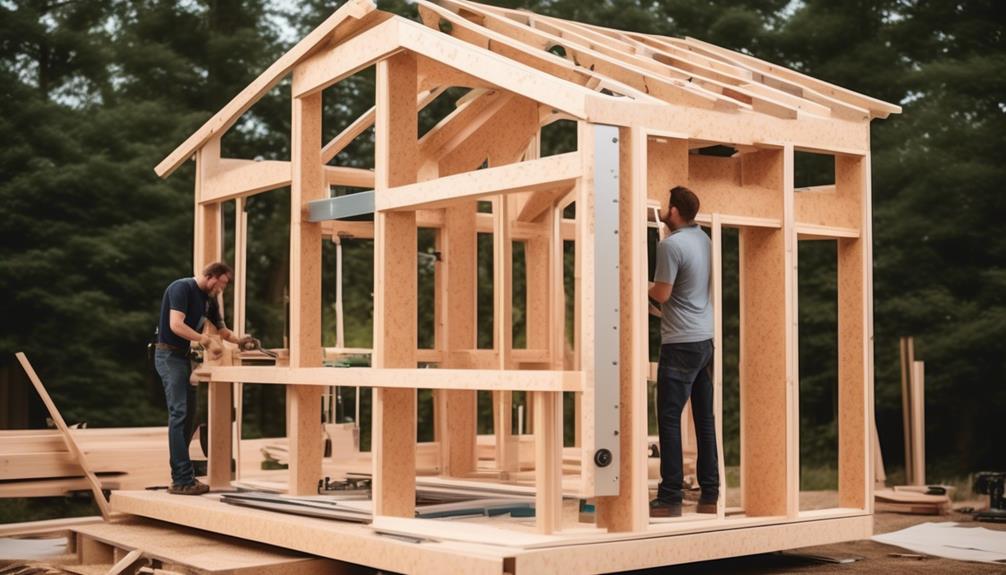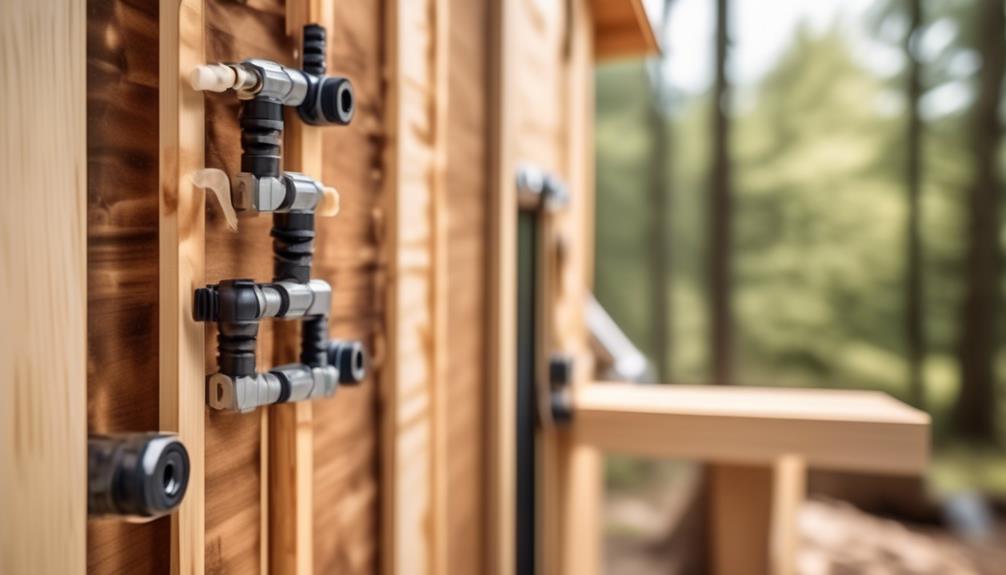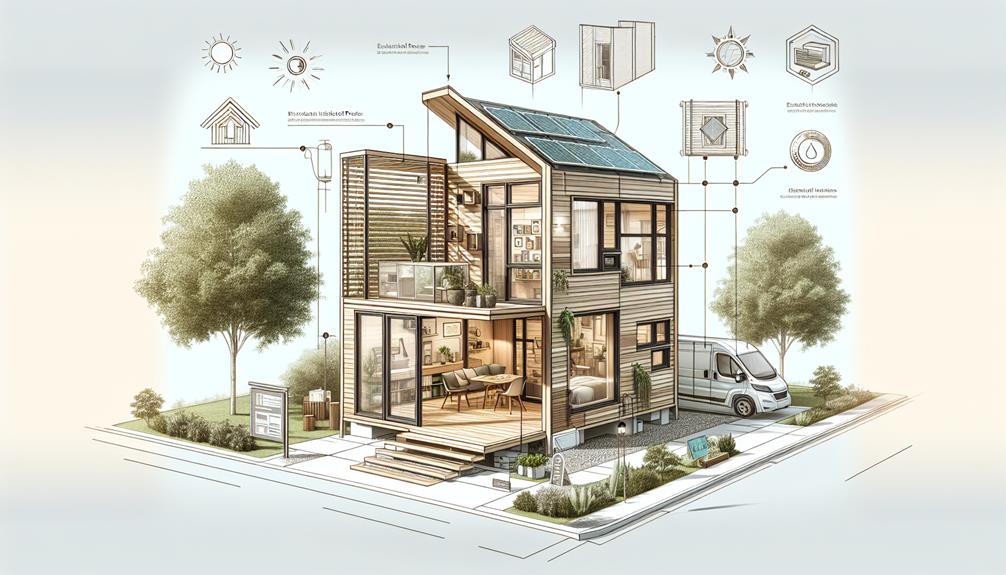Imagine stepping into your dream tiny house, feeling the warmth and coziness envelop you as you close the door behind you. The secret to achieving this idyllic vision lies in the game-changing benefits of Structural Insulated Panels (SIPs).
These innovative panels are transforming the world of tiny house construction, offering unparalleled energy efficiency, faster construction times, and improved indoor air quality. But that's just the beginning.
In this discussion, we will uncover the countless advantages of using SIPs, explore their technical aspects, installation and cost considerations, and even delve into the longevity of SIP tiny houses.
Get ready to embark on a journey that will revolutionize the way you think about building your dream tiny home.
Key Takeaways
- SIPs (structural insulated panels) offer high insulation ratings and improved energy efficiency for tiny house construction.
- Building with SIPs can simplify the construction process, reduce construction time, and improve indoor air quality.
- Proper planning and design using tools like AutoCAD are important when working with SIPs.
- Although there are potential challenges such as long lead times and difficulties in adapting or changing SIPs, the quality control provided by manufacturers and the durability and thermal performance of pre-constructed SIPs make them a valuable option for tiny house construction.
SIPs: Definition and Materials
SIPs, or structural insulated panels, are prefabricated building materials commonly used in the construction of tiny houses.
These panels consist of two layers of oriented strand board (OSB) with a core of expanded polystyrene foam.
The use of SIPs offers several benefits compared to traditional construction methods.
Firstly, SIPs provide high insulation ratings, resulting in improved energy efficiency and reduced heating and cooling costs.
Secondly, SIPs are easy to use and simplify the construction process, leading to shorter construction times.
Additionally, SIPs offer better quality control as they're manufactured off-site under controlled conditions.
However, it's important to note that using SIPs requires extensive planning and may be challenging to adapt or modify once installed.
Furthermore, acquiring SIPs may have longer lead times, and individuals with chemical sensitivities should consider potential issues.
Pros and Cons of Building With SIPs
When considering the construction of a tiny house, it's important to carefully weigh the pros and cons of using SIPs, or structural insulated panels.
- Benefits of SIPs for energy efficiency:
SIPs provide a high insulation rating, which helps to minimize energy consumption and reduce utility costs. They create a tight building envelope that prevents air leakage and heat transfer, resulting in a more comfortable living environment.
- Building with SIPs for improved indoor air quality:
SIPs have a solid core of expanded polystyrene foam, which doesn't produce volatile organic compounds (VOCs) or off-gassing. This improves indoor air quality and promotes a healthier living space.
- Simplicity of use:
SIPs are prefabricated and come in standard sizes, making them easy to install and assemble. This simplifies the construction process and reduces labor time.
- Reduced construction time:
Due to their prefabricated nature, SIPs can significantly speed up the construction process, allowing for quicker occupancy of the tiny house.
Carefully considering these pros and cons will help you make an informed decision about whether SIPs are the right choice for your tiny house construction project.
Technical Aspects of Building With SIPs

To delve into the technical aspects of building with SIPs, it's important to understand the benefits they offer in terms of energy efficiency, construction time, and indoor air quality.
When it comes to accurate planning and design, AutoCAD is an invaluable tool. Considerations for AutoCAD design include precise measurements and panel layouts to optimize the use of SIPs.
Additionally, quality testing is crucial for ensuring the durability and performance of SIPs. Certifications such as ASTM E84 for fire resistance and ASTM E119 for structural integrity should be sought.
Construction techniques such as proper sealing and connections are essential for maximizing the benefits of SIPs. Pre-constructed SIPs are recommended for their superior thermal performance and longevity.
Installation and Cost Considerations for SIP Panels
For successful installation and cost considerations of SIP panels in a tiny house, proper assembly instructions and attention to air and water sealing connections are crucial. To ensure a seamless installation process and optimize cost effectiveness, consider the following:
- Follow the manufacturer's instructions for SIP panel assembly, ensuring accurate alignment and secure fastening.
- Pay close attention to air and water sealing connections, using appropriate tapes, sealants, and gaskets to create a tight and weather-resistant envelope.
- Angle the top of the wall to match the roof pitch, allowing for a smooth transition and reducing the need for additional framing.
- Conduct a cost effectiveness analysis comparing SIPs to traditional materials, taking into account factors such as energy savings, labor costs, and long-term durability.
SIP Wall Connections for Tiny Houses

Ensure secure and weather-resistant connections between SIP panels in tiny house construction by employing proper wall connection techniques.
The success of your SIP tiny house project relies on selecting the right SIP wall connection methods and sealing techniques.
The two most common joint types for SIP wall connections are butt joints and spline joints. Butt joints are simpler but may require additional sealing to prevent air and water leaks. Spline joints provide better structural integrity and insulation, but they require precise cutting and fitting.
To ensure maximum weather-tightness, use adhesive sealants and foam tape to seal the joints and gaps between the SIP panels. These sealing techniques will help maintain the energy efficiency, durability, and long-term performance of your SIP tiny house.
Longevity and Final Thoughts on SIPs
Maximize the longevity and overall effectiveness of your SIP tiny house by considering key factors such as insulation properties, weather-tightness, and energy efficiency.
When it comes to SIPs durability, you can expect these panels to last for many years due to their strong composition and resistance to moisture and pests.
Additionally, SIPs offer excellent insulation, providing you with a highly energy-efficient structure that can reduce your heating and cooling costs.
The weather-tightness of SIPs ensures that your tiny house is protected from the elements, preventing air leaks and moisture intrusion.
With their superior performance in insulation, weather-tightness, and energy efficiency, SIPs are a game-changer in the world of tiny house construction, offering a durable and sustainable solution for innovative living spaces.
Frequently Asked Questions
Are SIPs Suitable for All Climate Conditions?
Yes, SIPs are suitable for all climate conditions. Their durability and energy efficiency make them a game-changer. SIPs provide excellent insulation, reducing energy costs and maintaining a comfortable indoor environment, regardless of the climate.
Can SIPs Be Used for Multiple Story Tiny Houses?
Yes, SIPs can be used for multi-story tiny houses. They provide exceptional structural integrity, making them suitable for building vertically. Their game-changing benefits include energy efficiency, faster construction, and improved indoor air quality.
Are SIPs More Expensive Than Traditional Construction Materials?
SIPs can be more expensive upfront compared to traditional construction materials. However, when considering the long-term durability and energy efficiency benefits, the cost comparison tilts in favor of SIPs.
Can SIPs Be Easily Repaired or Replaced if Damaged?
SIPs offer excellent repairability and durability. Damaged panels can be easily replaced without compromising the overall structure. This game-changing feature ensures that your SIP tiny house remains in top condition for years to come.
What Are the Fire Safety Considerations When Using SIPs in Tiny House Construction?
When using SIPs in tiny house construction, fire safety regulations and SIPs installation guidelines are crucial. Ensure compliance with local codes, follow manufacturer instructions, and incorporate fire-resistant materials for added protection.
Conclusion
In conclusion, using SIPs for your tiny house construction project can be a game-changer.
With their high insulation rating and simplified use, SIPs offer energy efficiency, faster construction time, and improved indoor air quality.
By accurately planning and designing with AutoCAD, obtaining certifications, and using proper construction techniques, you can ensure a successful build.
While installation and cost considerations are important, the longevity of SIP tiny houses can be extended through proper joint types and sealing methods.
Embrace the endless possibilities and benefits of SIPs for your tiny house adventure.

